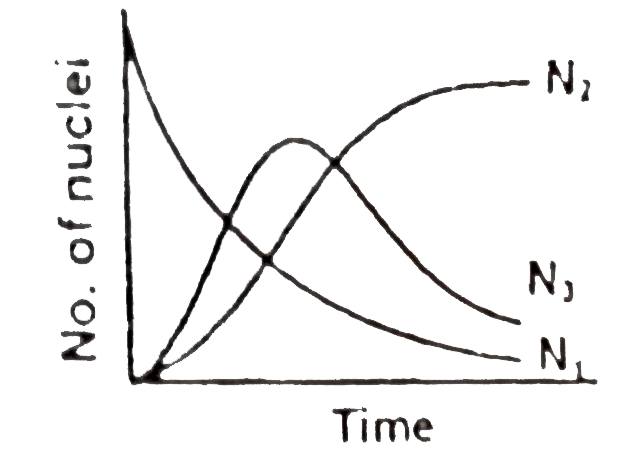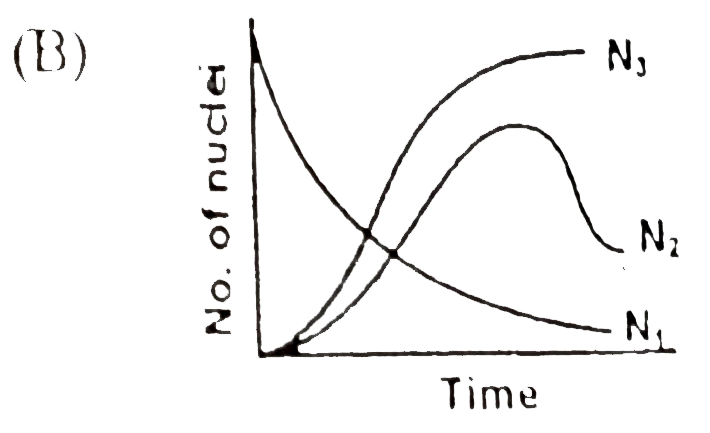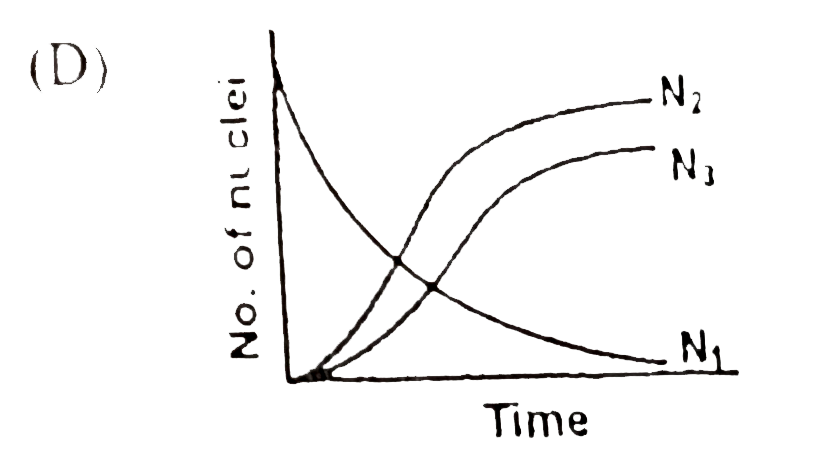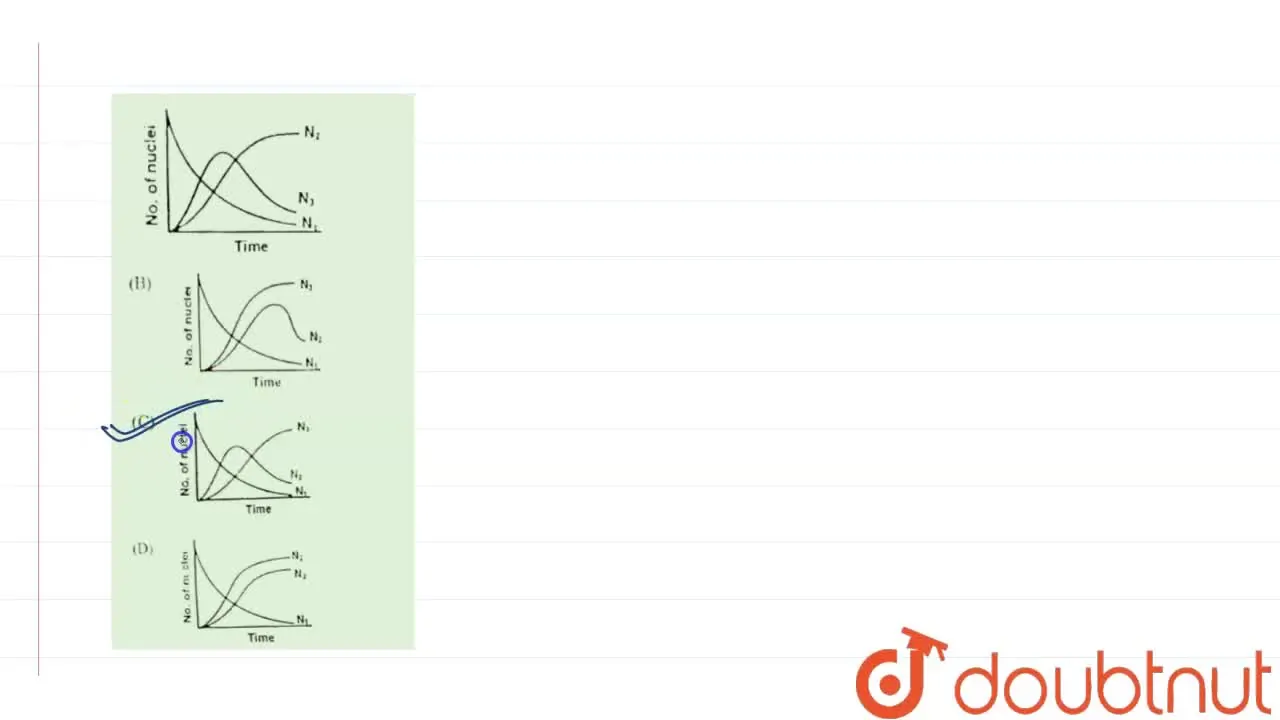Uranium 23892U is an unstable nucleaus. It decays to Thorium 23490Th, which is again an unstable nuclei which further decays to 23491Pa. Such decay is called successive dlsntegration. Let 23892U is called as A of decay constant λ1 and 23490Th is called as B of decay constant λ2 and stable nuclei 23491Pa is named as C. Here A is called parent nucleus and B is called daughter nucleus of A. Any two adjacent nuclei may be consider parem daughter nuclei. Suppose N1, N2 and N3 are number of nuclei A, B and C respectively at time t which undergoes decay. Then we can write
Aλ2−−→Bλ2−−→C
Rate of disintegration of A=dN1dt=−λ1N1
Rate of disintegration of B=−λ2N2 and net rate of formation of B=dN2dt=λ1N1−λ2N2
Rate of formation of nuclei C is equal to dN3dt=λ2N2
If at t=0, there are N0 number of nuclei of A, where as nuclei B and C are absent in the sample answer the following questions
The graph between N1, N2 & N3 with time can be best represented by




Step by step video & image solution for Uranium "_(92)^(238)U is an unstable nucleaus. It decays to Thorium "_(90)^(234)Th, which is again an unstable nuclei which further decays to "_(91)^(234)Pa. Such decay is called successive dlsntegration. Let "_(92)^(238)U is called as A of decay constant lambda_(1) and "_(90)^(234)Th is called as B of decay constant lambda_(2) and stable nuclei "_(91)^(234)Pa is named as C. Here A is called parent nucleus and B is called daughter nucleus of A. Any two adjacent nuclei may be consider parem daughter nuclei. Suppose N_(1), N_(2) and N_(3) are number of nuclei A, B and C respectively at time t which undergoes decay. Then we can write Aoverset(lambda_(2))(to)Boverset(lambda_(2))(to)C Rate of disintegration of A=(dN_(1))/(dt)= -lambda_(1)N_(1) Rate of disintegration of B= -lambda_(2)N_(2) and net rate of formation of B=(dN_(2))/(dt)=lambda_(1)N_(1)-lambda_(2)N_(2) Rate of formation of nuclei C is equal to (dN_(3))/(dt)=lambda_(2)N_(2) If at t=0, there are N_(0) number of nuclei of A, where as nuclei B and C are absent in the sample answer the following questions The graph between N_(1), N_(2) & N_(3) with time can be best represented by by Physics experts to help you in doubts & scoring excellent marks in Class 12 exams.
Similar Questions
Uranium .23892U is an ustable nucleus. It decays to Thorium .23892Th, which is again an unstable nucleus which further decays to .23491Pa. Let .23892U be called A of decay constant λ1 and .23490Th is called as B of decay constant λ2 and stable nuclei .23491Pa be called as C. Here A is called parent nucleus and B is called daughter nucleus of A. Any two adjacent nuclei may be consider parent or daughter nuclei A,B and C respectively at time 't'.
Then we can write Aλ1−−→Bλ2−−→C
Rate of disintergration of A=dN1dt=λ1N1
Rate of disintergration of B=dN2dt=λ1N1−λ2N2
Rate of formation of nuclei C is equal to
dN3dt=λ2N2
If at t=0, there are N0 number of nuclei of A where as nuclei B and C are absent in the sample Answer the following questions
Number of nuclei of B at any time t isView SolutionUranium .23892U is an ustable nucleus. It decays to Thorium .23892Th, which is again an unstable nucleus which further decays to .23491Pa. Let .23892U be called A of decay constant λ1 and .23490Th is called as B of decay constant λ2 and stable nuclei .23491Pa be called as C. Here A is called parent nucleus and B is called daughter nucleus of A. Any two adjacent nuclei may be consider parent or daughter nuclei A,B and C respectively at time 't'.
Then we can write Aλ1−−→Bλ2−−→C
Rate of disintergration of A=dN1dt=−λ1N1
Rate of disintergration of B=dN2dt=λ1N1−λ2N2
Rate of formation of nuclei C is equal to
dN3dt=−λ2N2
If at t=0, there are N0 number of nuclei of A where as nuclei B and C are absent in the sample Answer the following questions ltbgt Numeber of the nuclei of nuclei C at time t isView SolutionAt time t=0N1 nuclei of decay constant λ1&N2 nuclei of decay constant λ2 are mixed. The decay rate of the mixture at time 't' is:
View Solution.23892U has 92 protons and 238 nucleons. It decays by emitting an alpha particle and becomes:
View SolutionA nucleus of uranium decays at rest into nuclei of thorium and helium. Then :
View SolutionThe decay constant (λ) for radioactive decay is independent of
View SolutionNucleus A decays to B with decay constant λ1 and B decays to C with decay constant λ2. Initially at t=0 number of nuclei of A and B are 2N0 and N0 respectively. At t=to, no. of nuclei of B is 3N02 and nuclei of B stop changing. Find t0?
View SolutionA radioactive element 90X238 decay into 22283 , then the number of β− -particles emitted are
View SolutionA parent radioactive nucleus A (decay constant λA) converts into a radio-active nucleus B of decay constant λb, initially, number of atoms of B is zero At any time Na,Nb are number of atoms of nuclei A and B respectively then maximum velue of Nb.
View SolutionThe atomic mass of thorium .23490Th is 234.04359u, while that of protactinium .23491Pa is 234.04330u. Find the energy released when β decay changes 23490Th into Pa
View Solution


